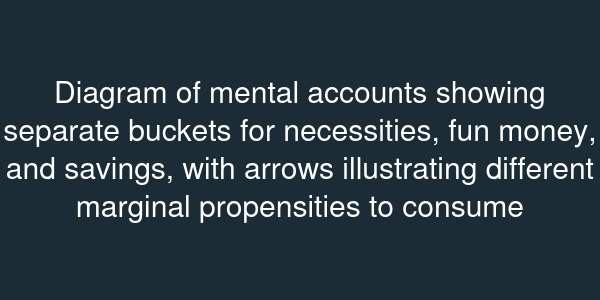Mental Accounting
Essential Questions
- What is mental accounting and how does it partition wealth into categories?
- How do mental budgets lead to both helpful and harmful decisions?
- How can organizations design systems that respect or reshape mental accounts?
Overview
You receive a $200 tax refund and treat it as "fun money," splurging on a concert, while simultaneously carrying credit-card debt at 20%. Economically, money is fungible; behaviorally, you keep separate mental accounts. Thaler coined "mental accounting" to describe this budgeting by story rather than by spreadsheet.
In this lesson, you will learn how mental accounts influence consumer decisions, examine examples like envelope budgeting and sunk cost fallacies, and evaluate policies that harness mental accounting, such as prize-linked savings.
The Architecture of Mental Accounts
Mental accounting partitions wealth into labeled categories: current income, current wealth, future income. People apply different marginal propensities to consume from each bucket. The propensity from a tax refund may be , while from a salary might be . This contradicts the permanent income hypothesis, which assumes uniform treatment of all dollars.
Mathematically, you can model mental accounts by defining utility as where is consumption from account . Constraints apply within each account: , the budget set by the individual. When a shock occurs (e.g., car repair), people may refuse to reallocate from vacation savings even if the marginal utility of dollars is higher in the repair account.

Evidence and Examples
Concert ticket experiments show sunk cost fallacies. If a person spends $100 on a ticket and feels ill, they still attend because the "entertainment" account would otherwise waste the expenditure. Households receiving a monthly "child benefit" use it mainly for child-related purchases even when debt payments would be more rational.
In corporate finance, managers categorize budgets into operating expenses versus capital expenditures, resisting transfers even when ROI differs. Governments use mental accounting to nudge behavior: earmarking gasoline tax revenue for road repairs increases public support because people see a one-to-one mapping.
Policy and Design
Fintech apps leverage mental accounting by offering digital envelopes. When you set a goal for emergency savings, the app locks funds until the goal is met, aligning with your mental budget. Prize-linked savings accounts transform saving into a game, moving dollars from the "lottery" account into the "savings" account without feeling like deprivation.
Policymakers must be aware of unintended consequences. Providing energy rebates as lump-sum checks may lead to higher energy use if recipients treat the rebate as a windfall. Structuring rebates as bill credits may better reinforce conservation.